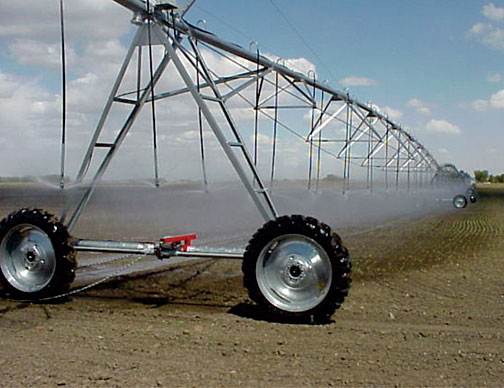| |
Irrigation System Application Efficiency Values | |
| |
|
|
| |
|
|
| | Measuring efficiency | Irrigation efficiency values
Different irrigation systems have different application efficiencies. Understanding the application efficiencies of different irrigation systems can help producers make critical irrigation management decisions for optimum crop yield and quality.
Irrigation system application efficiencies have steadily improved since the introduction of sprinkler irrigation in southern Alberta. Application efficiencies have increased from less than 30 percent in 1965 to greater than 70 percent in 2005 (Figure 1).

Figure 1. Modern centre pivot irrigation system.
Measuring Efficiency
Irrigation system application efficiency is defined as the amount of water stored in the root zone that is available to meet crop transpiration needs in relation to the amount of irrigation water applied to the field.
The efficiency of the different irrigation systems varies depending on many factors:
- type of irrigation system
- age of the system
- type of nozzles
- height of the sprinklers above the canopy
- upkeep of the system
- design of the field (gravity irrigation)
- size of the stream (gravity irrigation)
- type of crop and growth stage
- irrigation management
- environmental factors
- numerous other variables
System application efficiency values include any possible application losses. Losses can occur for a number of reasons:
- evaporation of water droplets before infiltration into the soil
- deep percolation of applied water below the crop rooting depth
- wind drift of water droplets away from the target area
- surface runoff from the field
Thus, most irrigation system application efficiencies are displayed as a range, reflecting the variation in factors that can affect system application efficiencies. For design, comparative, forecasting or irrigation analysis purposes, a single application efficiency value must usually be selected for each irrigation method.
Irrigation Efficiency Values
A table of irrigation system application efficiency values (Table 1) has been derived for use in the irrigation management products of the Irrigation and Farm Water Division of Alberta Agriculture and Rural Development.
These products include the following:
- Alberta Irrigation Management Model (AIMM)
- Irrigation Management Climate Information Network (IMCIN)
- Irrigation Demand Model (IDM)
- Farm Financial Impact and Risk Model (FFIRM)
These efficiency values are used for irrigation scheduling and for analysis of different irrigation development scenarios. The efficiency values included in the “Range” column of Table 1 reflect factors (listed above) that can contribute to a lesser or greater system application efficiency. The efficiency values included in the “Design” column of Table 1 are used for the irrigation management products and for irrigation development scenario analysis.
Table 1. System application efficiencies by irrigation method in southern Alberta.
| Irrigation Method | Range†
(Per cent) | Design
(Per cent) |
|
| Gravity - Undeveloped |  | 30 |
| Gravity - Developed | 40 - 80 | 62 |
| Sprinkler - Solid Set |  | 72 |
| Sprinkler - Hand-Move | 60 - 85 | 67 |
| Sprinkler - Wheel-move - 2 Laterals | 60 - 85 | 68 |
| Sprinkler - Wheel-move - 4 Laterals | 60 - 85 | 70 |
| Sprinkler - Pivot - High pressure | 75 - 90 | 73 |
| Sprinkler - Linear - High pressure | 75 - 90 | 73 |
| Sprinkler - Pivot - Low pressure | 75 - 95 | 84 |
| Sprinkler - Linear - Low pressure | 75 - 95 | 84 |
| Sprinkler - Volume gun - Stationary | 55 - 75 | 65 |
| Sprinkler - Volume gun - Traveller | 55 - 75 | 66 |
| Micro - Spray - Sprinkler | 70 - 95 | 82 |
| Micro - Drip - Trickle | 70 - 95 | 88 |
† Source: Howell, T.A. 2003. Irrigation Efficiency, in Encyclopedia of Water Science. Marcel Dekker, Inc. New York, New York. 1076 pp.
Prepared by
Ted Harms
Alberta Agriculture and Rural Development
For more information, contact
Alberta Ag-Info Centre
Call toll free at 310-FARM (3276)
Source: Agdex 563-1. October 2011. |
|
| |
|
|
| |
For more information about the content of this document, contact Ted Harms.
This document is maintained by Jennifer Rutter.
This information published to the web on October 21, 2011.
|
|